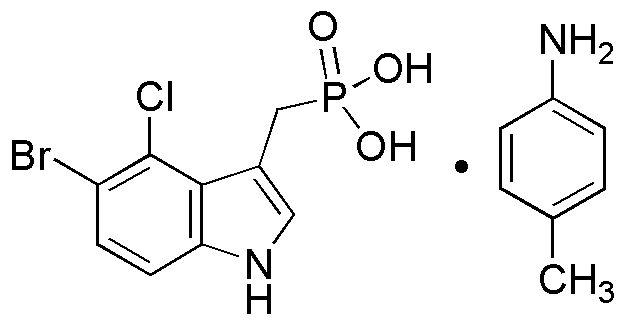5-Bromo-4-chloro-3-indolyl phosphate p-toluidine salt is widely utilized in research focused on:
- Biochemical Assays: This compound serves as a substrate in enzyme assays, particularly for phosphatases, enabling researchers to study enzyme kinetics and mechanisms effectively.
- Cell Biology: It is used in cell signaling studies, helping scientists investigate pathways involving phosphatidylinositol and other phospholipids, which are crucial for cellular functions.
- Drug Development: The compound plays a role in the development of pharmaceutical agents, particularly in targeting specific enzymes related to cancer and other diseases, providing a pathway for innovative therapies.
- Histochemistry: It is applied in histological staining techniques, allowing for the visualization of phosphatase activity in tissue samples, which is essential for diagnostic purposes.
- Environmental Monitoring: Researchers utilize this compound to detect and quantify phosphatase activity in environmental samples, aiding in the assessment of soil and water quality.
General Information
Properties
Safety and Regulations
Applications
5-Bromo-4-chloro-3-indolyl phosphate p-toluidine salt is widely utilized in research focused on:
- Biochemical Assays: This compound serves as a substrate in enzyme assays, particularly for phosphatases, enabling researchers to study enzyme kinetics and mechanisms effectively.
- Cell Biology: It is used in cell signaling studies, helping scientists investigate pathways involving phosphatidylinositol and other phospholipids, which are crucial for cellular functions.
- Drug Development: The compound plays a role in the development of pharmaceutical agents, particularly in targeting specific enzymes related to cancer and other diseases, providing a pathway for innovative therapies.
- Histochemistry: It is applied in histological staining techniques, allowing for the visualization of phosphatase activity in tissue samples, which is essential for diagnostic purposes.
- Environmental Monitoring: Researchers utilize this compound to detect and quantify phosphatase activity in environmental samples, aiding in the assessment of soil and water quality.
Documents
Safety Data Sheets (SDS)
The SDS provides comprehensive safety information on handling, storage, and disposal of the product.
Product Specification (PS)
The PS provides a comprehensive breakdown of the product’s properties, including chemical composition, physical state, purity, and storage requirements. It also details acceptable quality ranges and the product's intended applications.
Certificates of Analysis (COA)
Search for Certificates of Analysis (COA) by entering the products Lot Number. Lot and Batch Numbers can be found on a product’s label following the words ‘Lot’ or ‘Batch’.
Numéro de catalogue
Numéro de lot/série
Certificates Of Origin (COO)
This COO confirms the country where the product was manufactured, and also details the materials and components used in it and whether it is derived from natural, synthetic, or other specific sources. This certificate may be required for customs, trade, and regulatory compliance.
Numéro de catalogue
Numéro de lot/série
Safety Data Sheets (SDS)
The SDS provides comprehensive safety information on handling, storage, and disposal of the product.
DownloadProduct Specification (PS)
The PS provides a comprehensive breakdown of the product’s properties, including chemical composition, physical state, purity, and storage requirements. It also details acceptable quality ranges and the product's intended applications.
DownloadCertificates of Analysis (COA)
Search for Certificates of Analysis (COA) by entering the products Lot Number. Lot and Batch Numbers can be found on a product’s label following the words ‘Lot’ or ‘Batch’.
Numéro de catalogue
Numéro de lot/série
Certificates Of Origin (COO)
This COO confirms the country where the product was manufactured, and also details the materials and components used in it and whether it is derived from natural, synthetic, or other specific sources. This certificate may be required for customs, trade, and regulatory compliance.


